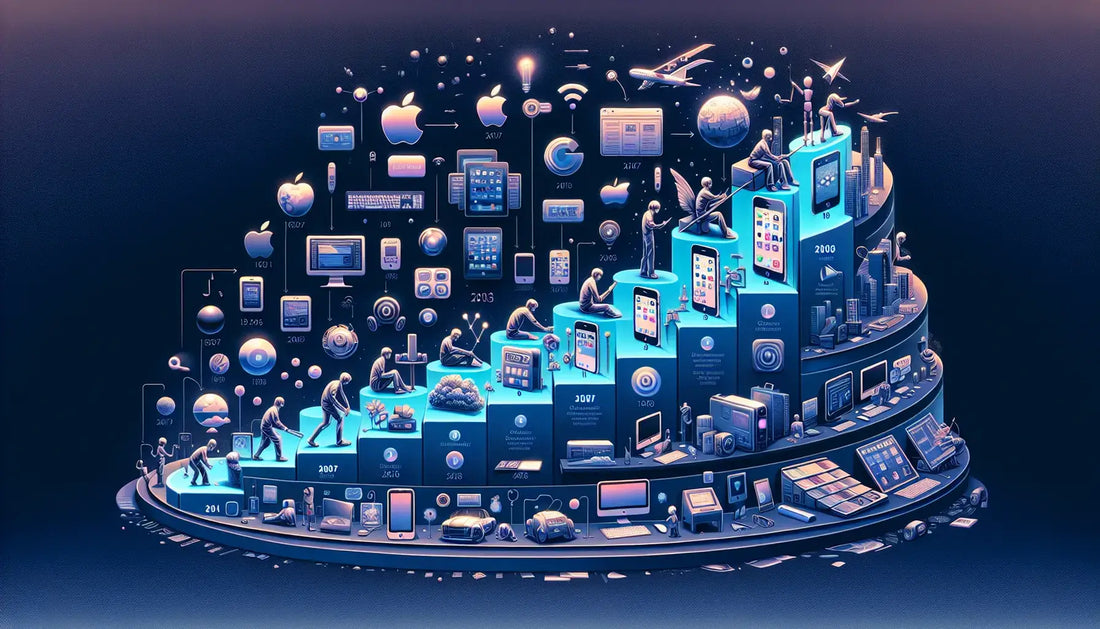Development of iOS
In 2007, iPhone OS 1, which later became iOS, was first revealed. This operating system has become one of the most influential in history, redefining the concept of a smartphone. Before its debut, mobile phone software was cumbersome and visually unappealing. However, iOS completely changed the game with its touch-based operating system.
The development process of iOS was highly secretive. Only Apple employees were allowed to be on the iPhone development team, and even they didn't know what they were working on. Two groups were assembled to create different versions of the iPhone, with one group focusing on converting the iPod into a phone and the other simplifying Mac OS X for a touch-based phone.
After almost twenty different concepts and prototypes, Steve Jobs chose the Mac OS X-based version developed by Scott Forstall. This version featured a completely touch-based interface, including a software keyboard and multitouch gestures like pinch to zoom. When it was revealed to the public in 2007, it had a massive impact on the tech industry, redefining the concept of a smartphone and making it more approachable and easy to use.
Since its debut, iOS has grown in ways no one expected. It has expanded to other devices like tablets, watches, cars, and even refrigerators. Each new version of iOS has brought new features and improvements, making it a powerful and versatile operating system.
Evolution of iOS
Since its debut in 2007, iOS has undergone significant changes and improvements. Let's take a look at the evolution of iOS through its various versions.
Introduction of iPhone OS 2 and the App Store
In 2008, iPhone OS 2 was released, and with it came the introduction of the App Store. This was a significant milestone for iOS, as it allowed users to download and install third-party applications onto their iPhones. The App Store quickly grew in popularity, offering a wide range of apps for users to enhance their iPhone experience.
Features and impact of iPhone OS 2:
- App Store introduced
- Ability to download and install third-party apps
- Increased functionality and versatility of iPhone
Updates in iPhone OS 3 and its significance
In 2009, iPhone OS 3 was released, further improving the iOS experience. This update introduced several new features and enhancements, including push notifications for third-party apps, copy and paste functionality, and MMS support in the Messages app. These additions greatly enhanced the usability and convenience of iOS.
Major changes in iOS 3:
- Push notifications for third-party apps
- Copy and paste functionality
- MMS support in Messages app
Major changes in iOS 4 and the introduction of multitasking
In 2010, iOS 4 was released, bringing significant changes to the operating system. One of the most notable features introduced in iOS 4 was multitasking, allowing users to switch between apps and perform tasks in the background. This greatly improved the efficiency and productivity of iOS devices.
Improvements and new features in iOS 4:
- Introduction of multitasking
- Improved efficiency and productivity
- Enhanced user experience
Improvements and new features in iOS 5 and iOS 6
iOS 5, released in 2011, and iOS 6, released in 2012, brought further improvements and new features to iOS. iOS 5 introduced the Notification Center, which consolidated all notifications in one place, and introduced iMessage for seamless messaging between iOS devices. iOS 6 added features such as Apple Maps, Passbook (later renamed Wallet), and improvements to Siri and the Photos app.
Key features in iOS 5 and iOS 6:
- Notification Center
- iMessage
- Apple Maps
- Passbook/Wallet
- Improvements to Siri and the Photos app
Overall, the evolution of iOS has been marked by continuous improvements, new features, and increased functionality. Each update has brought enhancements that have made iOS a powerful and versatile operating system, shaping the way we use our smartphones and other Apple devices.
Modern Features of iOS
As iOS continued to evolve over the years, Apple introduced several modern features that further enhanced the user experience. From iOS 7 to iOS 12, each new version brought new capabilities and improvements. Let's take a closer look at some of these modern features of iOS.
Introduction of Control Center and Interactive Notifications in iOS 7
In iOS 7, Apple introduced Control Center, a convenient feature that allows users to access commonly used settings and features with a simple swipe up from the bottom of the screen. This made it easier to adjust settings like Wi-Fi, brightness, and music playback without having to navigate through multiple menus. iOS 7 also introduced interactive notifications, which allowed users to take actions like replying to messages or accepting calendar invitations directly from the notification itself, without having to open the respective app.
Enhancements in iOS 8, including Continuity and Apple Pay
iOS 8 brought several notable enhancements to the operating system. One of the key features introduced in iOS 8 was Continuity, which allowed seamless integration between Apple devices. With Continuity, users could start a task on one device and pick up where they left off on another. iOS 8 also introduced Apple Pay, a secure and convenient way to make payments using the iPhone or iPad. Apple Pay revolutionized mobile payments by allowing users to simply tap their devices to a compatible payment terminal to complete a transaction.
Siri Integration with Third-Party Apps in iOS 9
iOS 9 saw Siri, Apple's virtual assistant, being integrated with third-party apps for the first time. This allowed users to use Siri to perform specific tasks within apps, such as sending messages on messaging apps or booking a ride on a ride-sharing app. The integration of Siri with third-party apps enhanced the overall functionality and convenience of iOS devices.
Features and Updates in iOS 10, such as Messages Improvements
iOS 10 introduced several new features and updates. One of the standout features was the improvements made to the Messages app. iOS 10 added support for rich links, which allowed users to view photos and videos directly within the message thread. It also introduced new messaging effects, such as balloons and confetti, to add more visual flair to conversations. Additionally, iOS 10 brought significant updates to other apps and features, including Photos, Maps, and Siri.
Optimization and Efficiency in iOS 12
iOS 12 focused on optimization and efficiency, particularly for older devices. Apple aimed to make iOS 12 run faster and smoother on all supported devices, even those that were several years old. The update brought significant performance improvements, with apps launching faster and tasks being executed more efficiently. iOS 12 also introduced new features like Screen Time, which helps users monitor and manage their device usage, and measured improvements in augmented reality capabilities.
With each new version of iOS, Apple has continued to push the boundaries of what is possible on a mobile operating system. From the introduction of Control Center and interactive notifications in iOS 7 to the optimization and efficiency in iOS 12, iOS has evolved to provide a seamless and powerful user experience.
FAQ
1. What was the impact of the App Store on iOS?
The App Store had a massive impact on iOS. It allowed users to download and install third-party applications, enhancing the functionality and versatility of iPhones. The App Store quickly grew in popularity, offering a wide range of apps that transformed the iPhone into a powerful and customizable device.
2. When did Siri become available on iOS?
Siri became available on iOS with the release of the iPhone 4S in 2011. It introduced a new way for users to interact with their iPhones by using voice commands and natural language processing. Siri has since become an integral part of the iOS ecosystem, offering a wide range of features and capabilities.
3. What were the major changes in iOS 7?
iOS 7 brought a major redesign to the operating system, transitioning from a skeuomorphic design to a more minimalistic and flat design. It introduced features like Control Center, which provided quick access to commonly used settings, and a new interface for the camera and photos app. iOS 7 also introduced features like AirDrop for easy file sharing and improved multitasking capabilities.
4. How did iOS improve the camera and photo features?
iOS improved the camera and photo features by introducing new capabilities and enhancements. For example, iOS 7 introduced a new interface for the camera app, making it easier to switch between different modes. It also added features like live photo filters and the ability to organize photos based on location and date. iOS also introduced features like Memories, which automatically creates photo albums based on people, places, and events.
5. What were the new features introduced in iOS 10?
iOS 10 introduced a range of new features, including a redesigned lock screen with interactive notifications and widgets. It also added features like Siri integration with third-party apps, a new Home app for controlling smart home accessories, and improvements to the Photos, Maps, and Messages apps. iOS 10 also introduced features like voicemail transcriptions, automatic app updates, and Apple Music.



